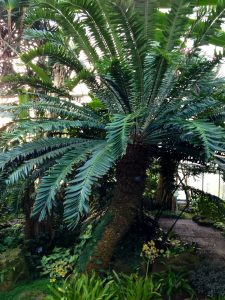Latin Name: Encephalartos natalensis R.A.Dyer & I. Verd.
Common Name: Natal giant cycad
Distribution: Endemic to South Africa (Eastern Cape & KwaZulu-Natal)
Habitat: On cliffs in open forests and escarpments, with very hot summers & cold winters. Has a wide altitudinal range being recorded from 200 up to 1,200 m
Description: A ‘living fossil’ A large cycad with a trunk up to 6m tall and 40 cm across, rigid leaves grow as a rosette at the top of the trunk between 1-3m in length. A cross section of the bright green and glossy leaves forms a shallow or steep vee. Separate male & female plants with yellow/tan cones produced in the crown. Fruit bright red.
Propagation: From seed or by removing basal suckers.
Cultivation: Grow in full sun in a humus-rich very well drained compost. While they will tolerate a light frost the are best from in a cool conservatory, placing outside only in the summer.
Uses: Starch from the trunk is used as flour in times of famine. The seed are poisonous but animals such as horn-bills eat only the outer flesh and discard the seed. Used as a garden ornamental in warm climates.
Restrictions: Poisonous Plant Parts, IUCN listed, CITES Appendix II Listed Plant
RBGE Data (May 2012):
- Accession number: 19380474
- Source: Mrs G Bailie donated a plant in 1938
- Provenance: Garden origin
- Location: Orchid & Cycad House
Check the RBGE Living Plant Database
Classification:
- SubClass: Cycadopsida
- Order: Cycadales
- Family: Zamiaceae

